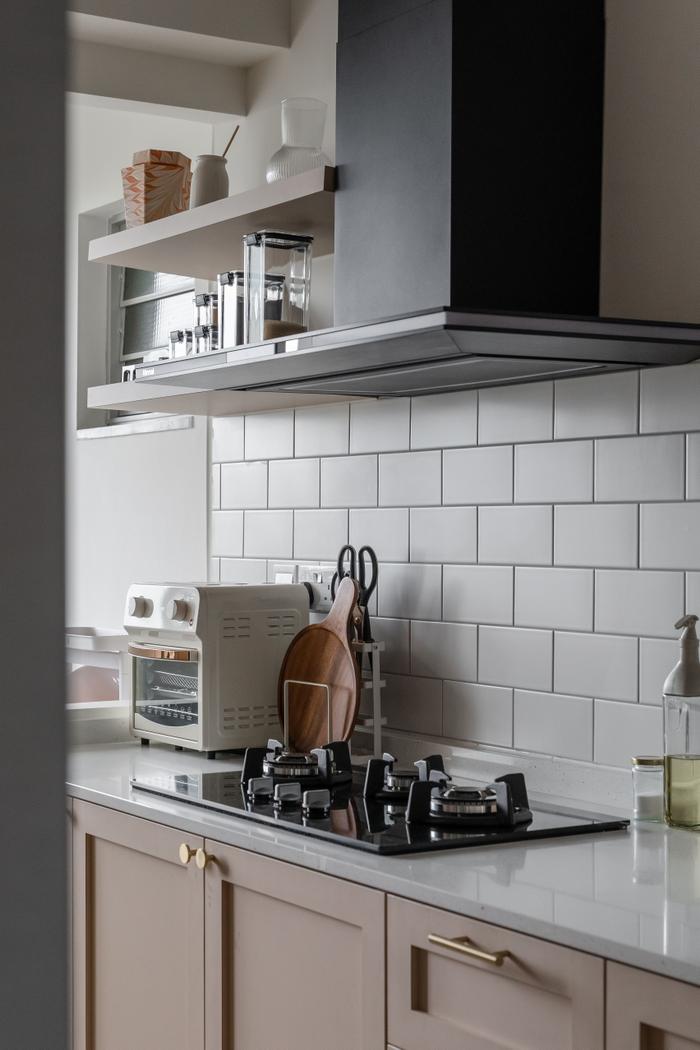Small details, big difference.
When there is a seemingly endless list of decisions to make during your home’s renovation, it’s easy to overlook some minor details.
Imagine realising that you forgot to conceal the unruly wires dangling from your wall-mounted TV, or that the niche in your shower ended up being an inch too small to fit tall-sized toiletries as you intended.
We asked our colleagues what are some of these details they regret, and to share practical advice that could help you during your own renovation planning. Here’s what they had to say.
In the kitchen...
1. Adjust your kitchen countertops to a non-standard height if it suits you better

View this project by Key Concept
The standard kitchen countertop height usually works for those of average height. That means if you’re fairly tall, petite or wheelchair-bound – or any height that makes a regular countertop uncomfortable to work at – you should adjust the height of your countertops.
Otherwise, you’d end up hunching or stretching in awkward positions to get to a workable height during food prep, which can cause aches and pains from just one cooking session alone.
2. Install pull-down racks in top cabinets to make the most of dead space

View this project by Authors • Interior & Styling
Here’s something many of us can relate to: avoiding the top kitchen cabinets because it’s troublesome to drag a chair over each time we need to access it. This often results in these storage spaces either becoming under-utilised and/or ‘hoarder zones’ that we forget about in our day-to-day lives.
A colleague recommends boosting the functionality of these underused zones with pull-down racks: you can easily organise them and it’s so much more convenient to grab what you need.
3. Make sure cabinet toe kicks are high enough to allow a vacuum/broom head to pass through

View this project by Mr Shopper Studio
Did you know that the recessed area between the bottom of your cabinet doors and the floor is called a ‘toe kick’? This ergonomic feature lets you slide your toes under the cabinets to work comfortably – but it can also trap a lot of dust and food (hello, ants!).
For the so-called ‘neat freaks’ among you, this is an area you’d probably target. To get all the dirt, make sure the height of the toe kick is enough for your vacuum, floor wiper or broom head to pass through fully to get to the innermost areas.
4. Take note of your home’s maximum electrical load when getting induction hobs

View this project by Ascend Design
Most new HDB flats have a maximum electrical load of 40 amps, which restricts the type of induction hob you can buy.
Electricians would recommend getting a smaller induction unit with a 20-amp socket, as running more powerful hobs alongside other appliances like air-conditioners may exceed your home’s rated load and cause trips.
If you cook heavily, you might have to switch to a gas hob since a smaller induction unit may not be sufficient for your needs.
5. In older HDB flats, make room for a gas cylinder if gas piping is not available

View this project by H Design
If you’ve bought an older resale HDB flat, you might discover that you don’t have the option to install a gas pipe. This doesn’t affect you if you’re planning on using an induction hob – but if you’re set on using a gas stove, be sure to set aside space for a gas cylinder in your kitchen cabinet.
In the living room…
6. Plan carpentry for loose, miscellaneous items
While most consider the carpentry essentials, like those in the kitchen and the bedroom, other areas of the house where you store miscellaneous items like shoes and cleaning supplies might fly over your head.

View this project by The Local INN.terior 新家室
For example, rather than struggling to find a loose shoe cabinet that matches your home’s aesthetic, our colleague recommends including it in your carpentry from the start. A big plus is that you can customise the shoe cabinet to a suitable size to fit your footwear.

Storage nook for robot vacuum at the bottom of a built-in; view this project by Studio CS
Similarly, you can hide away cleaning tools or appliances (think vacuums, mops and brooms) that you use frequently in built-in storage; they can also be rather unsightly to just leave out in the service yard or the storeroom.
7. Choose closed cabinets over open shelving for easier maintenance

View this project by Darwin Interior
With open shelving, you get a neat space for displaying decor and memorabilia, and easy access to kitchenware in spaces like the kitchen. Since they don’t look as bulky as top cabinets, they also make a smaller space look more open and inviting.

View this project by Anhans Interior Design
But as our colleague shares, the downside is that the shelves will probably get messy/dusty. You can’t hide the exposed items behind doors when guests are coming over!
For easier maintenance, try sticking to closed cabinets and/or keeping open shelves to a minimum.
In the bedroom…
8. Customise the height of wardrobe racks to suit the type of clothes you own

View this project by Concrid Interior
For those of you customising your wardrobe, think about the type of clothes you own and your storage needs. If you’re separating your clothes into upper and lower racks respectively, gauge the ideal height by the average length of your tops.
Or, if you tend to wear a lot of dresses and prefer to keep them in the upper rack, having a longer upper rack will ensure that they don’t get bunched up.
In the bathroom…
9. Make sufficient space for toiletries in shelves/cubbies

View this project by Ethereall
Like most, you might be getting a shelf or cubby for storing toiletries. Don’t forget to account for their height so that there’s sufficient space between multiple shelves/cubbies. The same applies to wall niches – or you might end up having to place larger shampoo bottles on the floor.
If you’re installing a ledge instead, make sure the depth is sufficient for your toiletries, which you can estimate by their average size.
Around your home…
10. Plan where to have sockets and switches for ease of use

View this project by Weiken.com
During space planning, think carefully about how you’ll move around your future spaces and what you’re using them for.
For example, instead of having just one light switch by the master bedroom entrance, having two-way switches in the bedroom means you won’t have to crawl out from your bed and walk to the other end of the room just to switch off the lights.
Or, if you often enjoy steamboat during festive occasions and family gatherings, you might need a socket close to the dining table to plug in a steamboat cooker.

View this project by Urban Home Design 二本設計家
Plan your socket location based on your appliances too: a colleague shared that her fridge socket is catered to the height of her current fridge and placed just above it.
This means that if she gets a taller fridge in the future, it would hit/block the socket and she wouldn’t be able to plug it in. In this instance, ‘future-proofing should also be considered, even when it comes to such tiny details!
Likewise, if you tend to have more kitchen appliances on your countertop, you should include more wall sockets.
12. Test paint in your home before committing – it can look different under lighting

View this project by Starry Homestead
Your chosen paint might look very different when actually used on your walls, compared to how it looks on paper or on a mobile application that helps you visualise your spaces with the colours. This is because paint can look different under different lighting conditions.
The solution? Test the colours in your home before going ahead with them, either by requesting/purchasing a sample can of wall paint from merchants and painting two coats over a small area of the room wall.
A reliable ID can help you avoid these unnecessary renovation regrets and more
If you’re looking to renovate, simply tell us your requirements below and we can get you personalised renovation quotes from five local interior design firms for free for a start.

 Get a budget estimate before meeting IDs
Get a budget estimate before meeting IDs